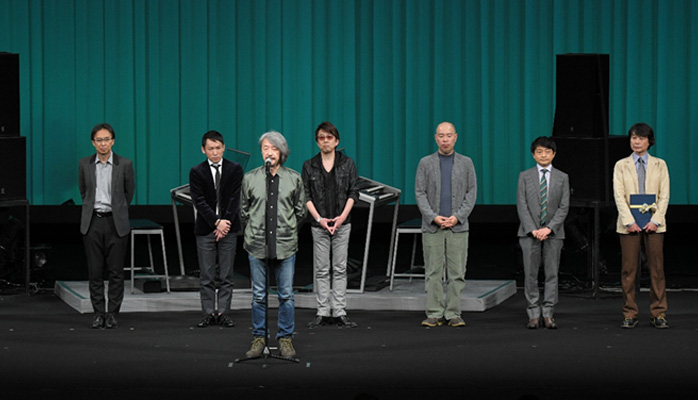2017ファイナル 審査員コメント
審査員コメント
Comments from the Judges
各日の表彰式で、審査員の皆さんから出場者へ向けてのコメントをいただきました。
より良い演奏をするためのアドバイスや、出場者の努力を称える言葉など、ファイナリストだけでなくYECに出場したすべての皆さんに向けたコメントの数々を、まとめてご紹介します。

(Performances)
- For the performer to convey what he or she wants to express to the listener in an easy-to-understand way, it is important to properly and boldly express an appropriate phrasing and suitable sense of rhythm.
(Arrangements)
- Composers create scores based on various intentions. The performers should create their arrangements after sufficient score reading and with respect for the composer.
(Original composition pieces)
- How an original composition piece touches the audiences’ hearts is affected by whether or not the theme of the piece speaks to them as music. The performers should devote efforts to creating appealing themes and melodies that leave an impression.
- Many of popular music pieces had sounds tending towards jazz fusion. The performers should take on the challenge of trying more different genres.
(Registrations)
- Choosing tones means selecting musical nuances. There should be closer relationships between tones and musical nuances, and the performers should ask themselves what nuances they want to include in their music through these tones.
- It is good to be able to perform while creating in one’s mind a spatial design showing which instruments are being played in what locations.
- Percussion instruments do not play supporting roles to the keyboard. If the performer plays based on the idea that there is another percussion performer expressing the music, the level of the music will rise, for classical in additional to original compositions and music with new styles.
- There were some cases of overly intense reverb in orchestral pieces. The performers should study how to use reverb that is in line with the size of the space, so that even small movements can be heard clearly.
(Piece selection)
- In choosing pieces for the Concours, the performers should select pieces they want to cherish and continue playing as part of their repertoires for a long time, even after the end of the Concours.
(Compulsory pieces)
- The compulsory pieces are comparatively simple pieces of music that can be played with various styles. The important point was whether the performer could fully read from the music the detailed, nuanced expressions that must be mastered.
- Performers should fully refine their ear and technique, including touch, phrasing, how to express linear movements in three dimensions, and how to express balanced polyphony.
(Compulsory arrangement pieces)
- Many performers chose similar genres for the compulsory arrangement pieces and free selection pieces. It would be good if they tried playing more different genres.
- Some arrangement raised doubts about whether the reharmonization was persuasive. It would be good if there was a stronger sense of backup for their arrangement.
- The piece will touch listeners if there is a skillful fusion between what the performer wants to say with the arrangement and the appealing qualities of the piece itself.
(Other comments)
- In the Junior Age Group 1, it was wonderful to see confident performances by students who had just started playing the Electone. From now on, they should be exposed to a broad range of music without being limited to the genres they prefer.
- One of the Electone’s social roles is its ability to convey to society, via passionate live performances, pieces such as orchestral music that are not performed frequently.
- The experience of performing in the Finals is of great importance. Performers should make use of this going forward, as the time they spent for the performance will definitely not go to waste.
審査員 Judges
| 井上 鑑 | 作・編曲家、キーボード奏者 | 栗山 和樹 | 作・編曲家 | 村松 崇継 | 作曲家、ピアニスト | 窪田 宏 | エレクトーンプレイヤー、キーボーディスト、作・編曲家 | 渡辺 睦樹 | エレクトーンプレイヤー | 難波 邦宏 | ヤマハ音楽振興会 音楽指導スタッフ |
|---|---|
| 小原 栄一 (審査員長) | ヤマハ音楽振興会 教育指導本部 本部長 |
| Akira Inoue | Composer / Music Arranger, Keyboard Player | Kazuki Kuriyama | Composer / Music Arranger | Takatsugu Muramatsu | Composer, Pianist | Hiroshi Kubota | Electone Player, Keyboardist, Composer / Music Arranger | Mutsuki Watanabe | Electone Player | Kunihiro Namba | Music Education Staff Yamaha Music Foundation |
|---|---|
| Eiichi Ohara [Chief Judge] |
General Manager, Music Education Division Yamaha Music Foundation |
お知らせ
- 2019年02月07日 ヤマハエレクトーンコンクール 主催変更のご案内

- 2019年01月31日 YEC2019 実施要項を公開しました。
- 2019年01月24日 YEC2018ファイナル 開催レポートを公開しました。
- 2019年01月24日 YEC2018ファイナル 審査員コメントを公開しました。
- 2018年12月18日 YEC2018ファイナル 受賞結果を公開しました。







(演奏について)
(編曲について)
(オリジナル曲について)
(レジストレーションについて)
(選曲について)
(課題演奏について)
(課題編曲について)
(その他)